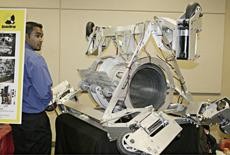Tyler Ebbitt is standing in front of a bright blue remote-controlled airplane with an 8-foot wingspan. The plane looks like any other, but there is something unusual about it: aerospace engineering senior Ebbitt and his team built it themselves.
“”We’ve been busting our butts,”” he said.
The plane, the UA’s entry at this year’s international Design-Build-Fly competition, was one of 57 different engineering projects at yesterday’s Engineering Design Day in the Student Union Memorial Center’s Grand Ballroom.
The event, sponsored by Maryland-based Lockheed Martin and London-based BAE Systems, featured projects from 270 engineering seniors ranging from planes to a machine that pasteurizes cows’ milk using ultraviolet light.
In addition to being a showcase, the event was also a competition. A large panel of judges made up of engineering professionals and educators from across the country judged students’ projects based on criteria including design, implementation and analysis.
Martha Ostheimer, director of the Interdisciplinary Engineering Design Program who organized the event, said that students’ projects are individually sponsored by a variety of engineering design firms, many of whom utilize students to help solve pressing real-world design problems.
The development process is a boon for students and professionals alike, Ostheimer said.
“”It works both ways,”” she said. “”It’s a win-win situation.””
Ostheimer added that the public event also serves as a recruitment tool and a chance to educate the public about challenges facing the world of engineering design.
“”It’s a great opportunity for them to display the results of their design processes,”” she said.
Aerospace engineering senior Jason Brockbank and his team received a grant from NASA to develop an unmanned airplane that replicates the flight stress patterns of full-size aircraft. The idea, Brockbank said, is to use the technology to test new aircraft without a pilot or a full-size plane.
“”We can push the envelope on tests without having to worry about losing a pilot,”” Brockbank said. “”With our economy we can’t afford to be losing planes and losing pilots.””
Brockbank’s design, the ‘aero-elastic scaled model,’ costs around $5,000 to build, compared to $180,000 or more for a full-sized plane.
Getting funding from groups like NASA and the Air Force allowed him to put his engineering education to work outside the classroom, Brockbank said, and Design Day is the perfect chance to showcase his work.
“”I enjoy being able to design something, build it, then test it in the field,”” Brockbank said.
Aerospace engineering senior Justin Novacek, who worked on the Design-Build-Fly project, said the experience of putting an idea to work in the world pays off despite the hard work required to produce such a project.
“”It’s a way to put our knowledge to a practical use and bring it out for the public to see,”” Novacek said. “”It’s rewarding to be able to look at something and look at it and say ‘we designed this, and it works.'””









